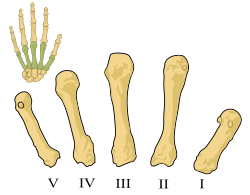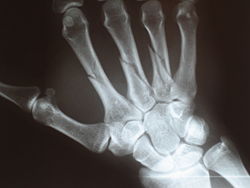Metacarpus
| Bone: Metacarpals | |
|---|---|
 |
|
| The five metacarpal bones, numbered. | |
 |
|
| Multiple fractures of the metacarpals (aka broken hand). |
The metacarpus is the intermediate part of the hand skeleton that is located between the phalanges (bones of the fingers) distally and the carpus which forms the connection to the forearm. The metacarpus consists of metacarpal bones.
Contents |
Common characteristics of the metacarpal bones
Each consists of a body and two extremities.
Body
The body (corpus; shaft) is prismoid in form, and curved, so as to be convex in the longitudinal direction behind, concave in front.
It presents three surfaces: medial, lateral, and dorsal.
- The medial and lateral surfaces are concave, for the attachment of the interosseus muscles, and separated from one another by a prominent anterior ridge.
- The dorsal surface presents in its distal two-thirds a smooth, triangular, flattened area which is covered in by the tendons of the Extensor muscles. This surface is bounded by two lines, which commence in small tubercles situated on either side of the digital extremity, and, passing upward, converge and meet some distance above the center of the bone and form a ridge which runs along the rest of the dorsal surface to the carpal extremity. This ridge separates two sloping surfaces for the attachment of the Interossei dorsales.
To the tubercles on the digital extremities are attached the collateral ligaments of the metacarpophalangeal joints.
Base
The base or carpal extremity (basis) is of a cuboidal form, and broader behind than in front: it articulates with the carpus, and with the adjoining metacarpal bones; its dorsal and volar surfaces are rough, for the attachment of ligaments.
Head
The head or digital extremity (capitulum) presents an oblong surface markedly convex from before backward, less so transversely, and flattened from side to side; it articulates with the proximal phalanx.
It is broader, and extends farther upward, on the volar than on the dorsal aspect, and is longer in the antero-posterior than in the transverse diameter.
On either side of the head is a tubercle for the attachment of the collateral ligament of the metacarpophalangeal joint.
The dorsal surface, broad and flat, supports the tendons of the extensor muscles; the volar surface is grooved in the middle line for the passage of the Flexor tendons, and marked on either side by an articular eminence continuous with the terminal articular surface.
Articulations
Besides their phalangeal articulations, the metacarpal bones articulate as follows:
- the first with the trapezium;
- the second with the trapezium, trapezoid, capitate and third metacarpal;
- the third with the capitate and second and fourth metacarpals;
- the fourth with the capitate, hamate, and third and fifth metacarpals;
- and the fifth with the hamate and fourth metacarpal.
See also
- Bone terminology
- Boxer's fracture
- Terms for anatomical location
- Carpometacarpal bossing
Additional images
This article was originally based on an entry from a public domain edition of Gray's Anatomy. As such, some of the information contained herein may be outdated. Please edit the article if this is the case, and feel free to remove this notice when it is no longer relevant.
|
|||||||||||||||||